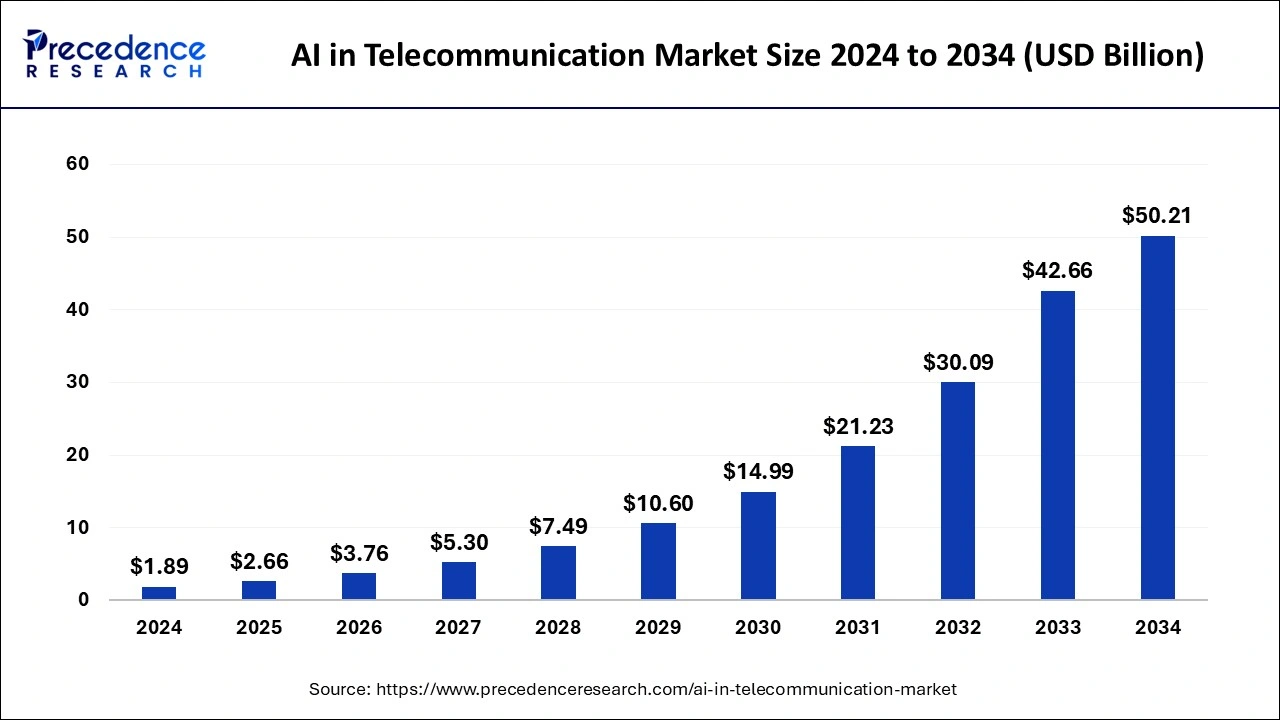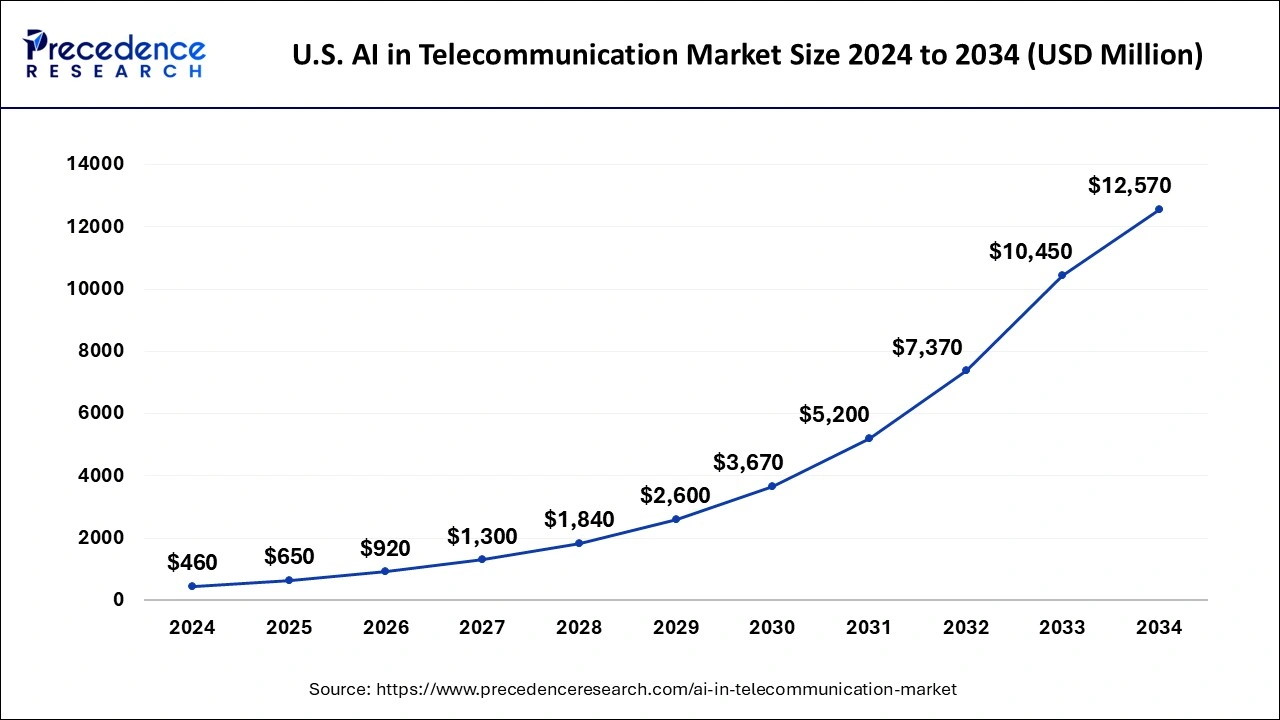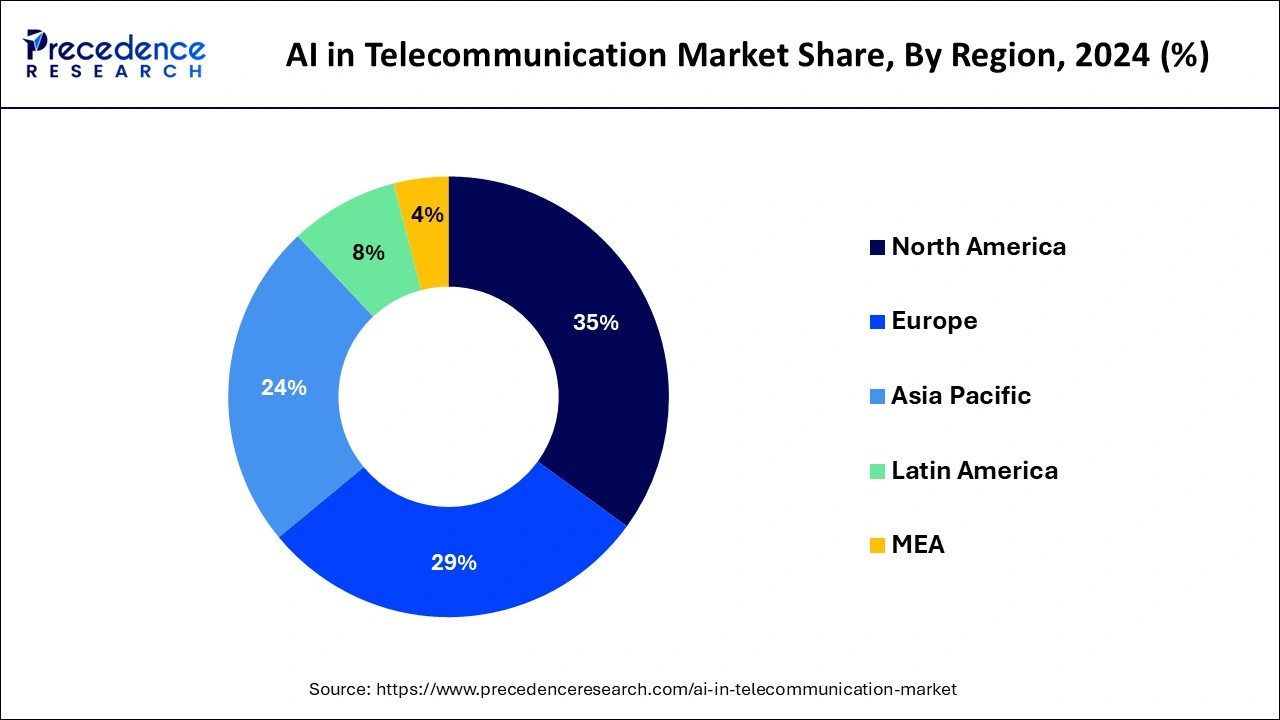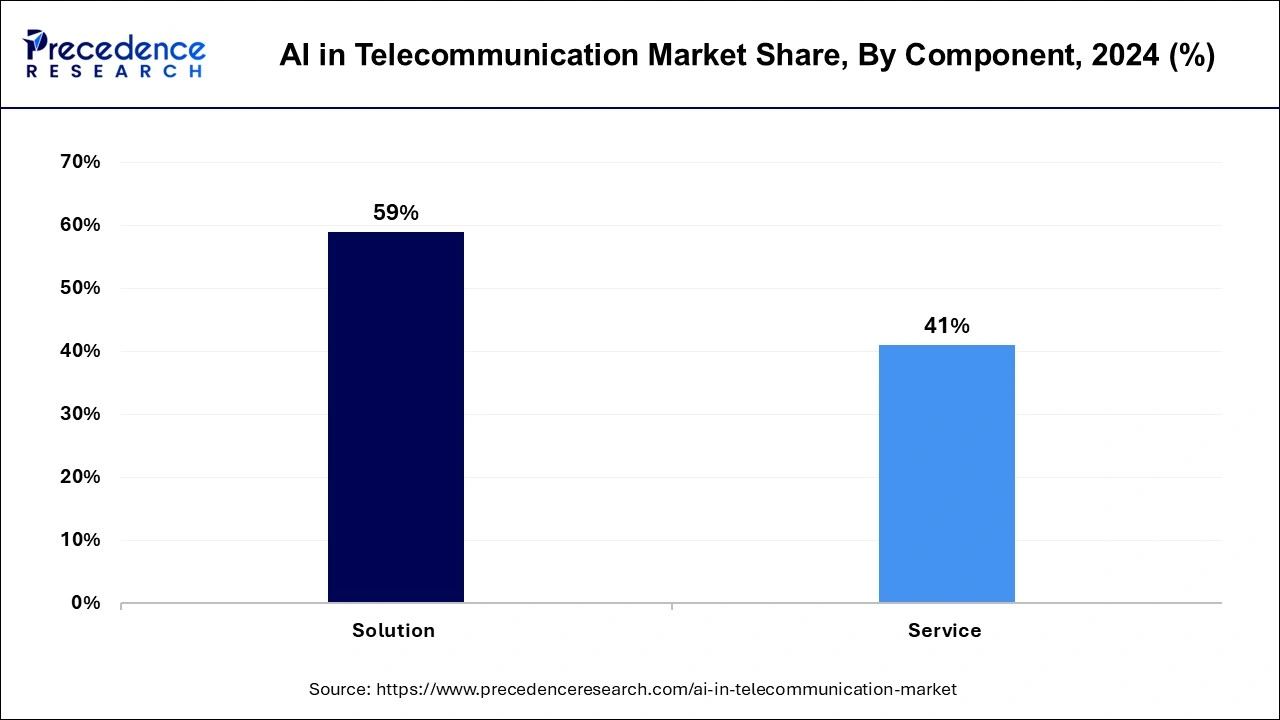February 2025
The global AI in telecommunication market size is calculated at USD 2.66 billion in 2025 and is forecasted to reach around USD 50.21 billion by 2034, accelerating at a CAGR of 38.81% from 2025 to 2034. The North America AI in telecommunication market size surpassed USD 660 million in 2024 and is expanding at a CAGR of 39.04% during the forecast period. The market sizing and forecasts are revenue-based (USD Million/Billion), with 2024 as the base year.
The global AI in telecommunication market size was estimated at USD 1.89 billion in 2024 and is projected to hit around USD 50.21 billion by 2034, growing at a CAGR of 38.81% from 2025 to 2034. The global AI in telecommunication market is driven by the rapid expansion of telecom companies worldwide. Moreover, the growing focus on enhancing customer experience and reducing operational costs further contributes to market expansion

The U.S. AI in telecommunication market size was valued at USD 460 million in 2024 and is expected to reach around USD 12570 million by 2034, growing at a CAGR of 39.21% from 2025 to 2034.

North America held a share of 35% in the AI in telecommunication market due to robust technological infrastructure, widespread adoption of advanced technologies, and a thriving telecommunications sector. The region's early and extensive deployment of 5G networks has spurred the integration of AI for network optimization and customer service enhancement. Additionally, the presence of key market players, substantial research and development activities, and favorable regulatory support contribute to North America's dominance. This region remains at the forefront of AI in telecommunication, driving innovation and shaping the industry's growth trajectory.

Asia-Pacific is poised for accelerated growth in the AI in telecommunication market due to a confluence of factors. With a large and rapidly expanding population, increased smartphone penetration, and significant investments in 5G infrastructure, the region offers immense opportunities for AI integration in telecommunications. Governments and businesses are actively embracing AI technologies to enhance network efficiency, provide innovative services, and meet the escalating demand for advanced communication solutions. This favorable environment positions the Asia-Pacific region as a key driver for the robust expansion of AI in telecommunication market.
Meanwhile, Europe is witnessing substantial growth in the AI in telecommunication market, driven by proactive measures, heightened investments, and a dedicated focus on digital evolution. Governments and businesses in the region are strategically implementing AI to improve telecommunication network efficiency, elevate customer experiences, and streamline operational processes. The participation of major industry players, favorable regulatory environments, and a technologically engaged consumer base contribute to the swift integration of AI technologies. This expansion reflects a collective commitment to staying competitive globally in the telecommunications arena and harnessing the transformative power of artificial intelligence.
AI is transforming the telecommunication industry by boosting network efficiency, streamlining operations, and elevating customer experiences. Advanced algorithms analyze extensive data sets, predicting and preventing network failures for proactive maintenance and reduced downtime. Predictive analytics powered by AI optimize bandwidth allocation, ensuring resource efficiency and enhanced network performance. In customer service, AI-driven virtual assistants enhance communication with instant responses and personalized interactions.
Additionally, AI simplifies the implementation of 5G networks by automating intricate tasks such as network slicing and dynamic resource allocation. These advancements position AI as a key player in reshaping telecommunication into a more responsive, reliable, and user-friendly ecosystem, ushering in the next era of communication technologies.
| Report Coverage | Details |
| Growth Rate from 2025 to 2034 | CAGR of 38.81% |
| Market Size in 2025 | USD 2.66 Billion |
| Market Size by 2034 | USD 50.21 Billion |
| Base Year | 2024 |
| Forecast Period | 2025 to 2034 |
| Segments Covered | By Component, By Application, and By Technology |
| Regions Covered | North America, Europe, Asia-Pacific, Latin America, and Middle East & Africa |
Network optimization impact
The surge in market demand for AI in telecommunication is significantly driven by the impactful role of network optimization. As telecommunication networks continue to evolve, the demand for enhanced efficiency and performance becomes paramount. AI's ability to optimize networks by predicting and preventing failures, ensuring optimal resource allocation, and reducing downtime has garnered substantial attention.
Reports indicate that telecom companies incorporating AI-driven network optimization experience a remarkable surge in customer satisfaction, with a notable decrease in downtime by approximately 30%. This tangible improvement in network reliability and performance not only enhances the overall user experience but also positions AI as a crucial tool for telecom operators aiming to stay competitive in the dynamic market landscape.
Furthermore, the market demand is propelled by the cost-saving implications of network optimization through AI. Telecom companies adopting AI-driven network optimization solutions report a significant reduction in operational costs, with streamlined processes and efficient resource allocation. This cost-effectiveness not only improves the bottom line for telecom operators but also makes AI in telecommunications an attractive investment, fostering a growing demand for innovative solutions that optimize network infrastructure.
Interoperability issues
Interoperability issues stand as a significant restraint to the market demand for AI in the telecommunication sector. The integration of AI solutions into existing telecommunication infrastructure often encounters challenges in ensuring seamless compatibility. Telecommunication networks typically consist of diverse technologies, protocols, and legacy systems, making it complex to integrate AI seamlessly.
This interoperability challenge can lead to disruptions, increased implementation times, and additional costs for telecom operators. As the demand for AI in Telecommunication grows, the inability to address interoperability issues hampers the industry's ability to fully leverage the potential benefits of AI technologies. Telecom companies may hesitate to adopt AI solutions if they perceive potential disruptions to their existing operations. Overcoming these interoperability challenges requires collaborative efforts between technology providers, standardization bodies, and telecom operators to develop solutions that seamlessly integrate AI into diverse telecommunication ecosystems, ensuring a smoother transition and fostering greater market demand for AI in the Telecommunication sector.
Financial services enhancement
The successful integration of 5G networks presents significant opportunities for AI in the telecommunication market. 5G's high-speed, low-latency capabilities create a fertile ground for AI applications to thrive. AI can play a pivotal role in optimizing and managing 5G networks, ensuring efficient resource allocation, dynamic network slicing, and handling the complexities associated with the next generation of connectivity.
The demand for AI-driven solutions in 5G integration is driven by the need for real-time analytics, predictive maintenance, and enhanced network performance. Telecom operators can leverage AI to capitalize on the full potential of 5G, offering innovative services and meeting the evolving demands of users. The symbiotic relationship between 5G and AI opens avenues for transformative applications, from smart cities and IoT to augmented reality, creating a dynamic landscape where the success of 5G integration becomes a catalyst for the continued growth and evolution of the AI in Telecommunication market.
The solution segment had the highest market share of 59% in 2024. In the AI in telecommunication market, the solution segment encompasses a suite of AI-driven technologies designed to address specific challenges within the telecommunication industry. These solutions typically include predictive analytics, network optimization tools, virtual assistants, and automation platforms. Trends in this segment indicate a growing emphasis on solutions that enhance network efficiency, customer experiences, and cyber security. As telecom operators seek comprehensive AI-driven answers to complex operational issues, the solution segment is witnessing a surge in innovation to meet the evolving demands of the industry.

The service segment is anticipated to witness rapid growth at a significant CAGR of 44.9% during the projected period. In the AI in telecommunication market, the service segment encompasses offerings that support the deployment, integration, and maintenance of AI solutions. These services include consulting, system integration, training, and support services. As telecom operators increasingly adopt AI technologies, there is a growing trend towards specialized AI service providers offering tailored solutions to meet the unique requirements of the telecommunication industry. The demand for expert services reflects the need for seamless integration of AI into existing infrastructures, ensuring optimal functionality, and maximizing the benefits of AI-driven innovations.
The customer analytics segment has held a 29% market share in 2024. In the AI in telecommunication market, the customer analytics segment involves leveraging artificial intelligence to analyze customer data comprehensively. This includes patterns, preferences, and behaviors, enabling telecom operators to enhance customer experiences, personalize services, and optimize marketing strategies.
The trend in customer analytics within AI for telecommunication is marked by a shift towards predictive analytics, sentiment analysis, and real-time insights. Telecom companies increasingly rely on AI-driven customer analytics to anticipate customer needs, reduce churn, and deliver tailored services, thereby improving overall customer satisfaction and loyalty.
The virtual assistance segment is anticipated to witness rapid growth over the projected period. In the AI in telecommunication market, the virtual assistance segment involves employing AI-driven virtual assistants to enhance customer interactions and support services. These smart virtual agents respond to user queries in real-time, elevating overall customer experience.
A current trend in this sector is the growing incorporation of natural language processing (NLP) and machine learning algorithms. This integration enables virtual assistants to better understand and respond to user queries, streamlining customer support processes. The result is improved efficiency, reduced response times, and an overall enhanced communication experience within the telecommunication industry.
The data analytics segment has held a 32% market share in 2024. Within the AI in telecommunication market, the data analytics segment centers on using advanced analytics to extract valuable insights from extensive telecom data. This involves employing machine learning algorithms and statistical models to analyze network performance, customer behavior, and operational data. Trends in this sector include the growing embrace of predictive analytics for proactive network maintenance, real-time analysis to enhance decision-making, and the incorporation of AI-powered analytics to boost overall efficiency and elevate customer experiences in the telecommunications industry.
The machine learning segment is anticipated to witness rapid growth over the projected period. The machine learning segment in the AI in telecommunication market involves the application of algorithms that enable systems to learn from data and improve their performance over time. In telecommunication, machine learning is employed for network optimization, predictive maintenance, and customer service enhancement.
Recent trends indicate a growing reliance on machine learning for real-time analytics, anomaly detection, and automation of complex tasks. As telecom operators seek to improve operational efficiency and customer experiences, the machine learning segment continues to be a pivotal technology driving innovation in the AI in telecommunication market.
By Component
By Application
By Technology
By Geography
For inquiries regarding discounts, bulk purchases, or customization requests, please contact us at sales@precedenceresearch.com
No cookie-cutter, only authentic analysis – take the 1st step to become a Precedence Research client
February 2025
July 2024
April 2024
April 2024